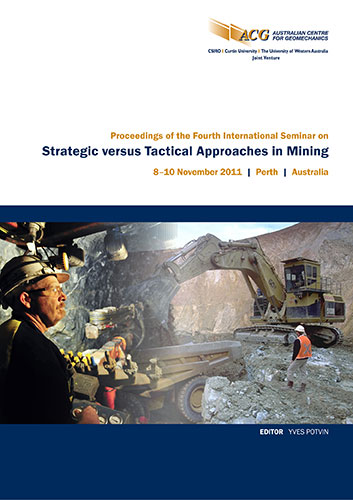Shotcrete – how to fill the gap?

|
Authors: Ferland, P; Fuller, A Paper is not available for download Contact Us |
DOI https://doi.org/10.36487/ACG_rep/1108_09_Ferland
Cite As:
Ferland, P & Fuller, A 2011, 'Shotcrete – how to fill the gap?', in Y Potvin (ed.), Strategic versus Tactical 2011: Proceedings of the Fourth International Seminar on Strategic versus Tactical Approaches in Mining, Australian Centre for Geomechanics, Perth, pp. 97-128, https://doi.org/10.36487/ACG_rep/1108_09_Ferland
Abstract:
Over the last 20 years, shotcrete has increasingly become an alternative to mesh. For many mining operations, implementation of shotcrete is a strategic decision predicated on enhanced productivity and safer working environments, while additionally providing an improved ability to overcome difficult ground conditions. However, the poor tactical aspects of implementation, including management, engineering and production operations, have undermined the success of shotcrete for many operators. This paper discusses the implementation of a shotcrete system on a mine site, from both strategic and tactical approaches.
References:
Archibald, J.F., Espley-Boudreau, S.J. and Degagne, D.O. (2000) Economic and productivity comparison of bolts and screen, shotcrete and spray-on mine coatings, in Proceeding 102nd Annual General Meeting of the Canadian Institute of Mining, Metallurgy and Petroleum, Toronto, Ontario (CD ROM publication).
ASTM C 1550, Standard Test Method for Flexural Toughness of Fibre-Reinforced concrete (Using centrally Loaded Round Panel).
Barton, N., Lien, R. and Lunde, J. (1974) Engineering classification of rock masses for the design of tunnel support, Rock Mechanics, Vol. 6, No. 4, pp. 189–236.
Bernard, E.S. (2009) Early-age re-entry under fresh fibre reinforced shotcrete, in Shotcrete for Underground Support XI, Felix Amberg, M.o.S. ETHZ, SIA, Switzerland, K.F. Garshol, BASF Construction Chemicals, LLF, USA Eds, ECI Symposium Series, Vol. P11.
Bernard, E.S. (2007) Early-age load resistance of fibre reinforced shotcrete linings, Tunnelling and Underground Space Technology, Vol. 23, pp. 451–460.
Dimmock, R., Rispin, M. and Knight, B. (2003) Early Re-Entry into Working Faces in Mines through Modern Shotcrete Technology, CIM-AGM, Montreal, Canada, 2003.
Dunn, P.G. (2009) Hydroscaling technology for rapid drift development, in Proceedings First International Seminar on Safe and Rapid Development Mining (SRDM), P. Dight (ed), 6–7 May 2009, Perth, Australia, Australian Centre for Geomechanics, Perth, pp. 61–68.
EFNARC (1996) European Specification for Sprayed Concrete.
Grimstad, E. and Barton, N. (1993) Updating the Q-System for NMT, in Proceedings of the International Symposium on Sprayed Concrete: Modern Use of Wet Mix Sprayed Concrete for Underground Support, R. Kompen, O. Opsahl and K. Berg (eds), Oct 1993, Fagernes, Norway, Norwegian Concrete Association, pp. 46–66.
McCreath, D.R. and Kaiser, P.K. (1992) Evaluation of current support practices in burst-prone ground and preliminary guidelines for Canadian hardrock mines, in Rock support in mining and underground construction, Proceedings International Symposium on Rock Support, P.K. Kaiser and D.R. McCreath (eds), Sudbury, Canada, Rotterdam, Balkema, pp. 611–619.
Methven, G. (2004) In cycle application of fibre reinforced shotcrete, Shotcrete, more engineering developments, Balkema, pp. 193–200.
Morgan, D.R., Chen, L. and Beaupré, D. (1990) Toughness of Fibre Reinforced Shotcrete.
Mundike, S. (2005) Application of fibre-reinforced shotcrete (Fibrecrete) support in drift at Nchanga underground mine CB, in Proceedings of the Seminar on Shotcrete Technology for the Mining Industry, Mining Research Directorat, Ontario.
Ortlepp, W.D. and Stacey, T.R. (1998) Performance of tunnel support under large deformation static and dynamic loading, Tunnelling and Underground Space Technology, Vol. 13, Issue 1, January–March 1998, pp. 15–21.
O’Toole, D. and Pope, S. (2006) Design, Testing and Implementation of ‘In-Cycle’ Shotcrete in The Northern 3500 Orebody, in Proceedings of the 10th International Conference on Shotcrete for Underground Support X (SUS-X), Whistler, Canada, D. Morgan and H. Parker (eds), American Society of Civil Engineers, pp. 316–327.
Papworth, F. (2002) Design Guidelines for The Use of fiber-Reinforced Shotcrete in Ground Support, Shotcrete Magazine, Vol. 1, pp. 16–21.
Rispin, M. (2005) Reentry into a Shotcreted, Underground Heading, Shotcrete Magazine, Spring, pp. 26–30.
Rispin, M., Knight, B. and Dimmock, R. (2003) Early Re-Entry into Working Faces in Mines through Modern Shotcrete Technology—Part II, Canadian Institute of Mining - Mines Operations Centre (CIM-MOC), Saskatoon, Canada.
Rose, D. (1985) The Role of Shotcrete in Hard-Rock Mines, in Underground Mining Method: Engineering Fundamentals and International Case Studies, W.A. Hustrulid and R. Bullock (eds), Society of Mining Engineers, pp. 579–592.
Vandewalle, M. (1996) Tunneling the World, Fourth Edition, N.V.Bekaert S.A.
Windsor, C.R. (1998) Structural design of shotcrete linings, in Proceedings 1998 Australian Shotcrete conference, IBC Conferences: Sydney, pp. 1–34.
© Copyright 2025, Australian Centre for Geomechanics (ACG), The University of Western Australia. All rights reserved.
View copyright/legal information
Please direct any queries or error reports to repository-acg@uwa.edu.au
View copyright/legal information
Please direct any queries or error reports to repository-acg@uwa.edu.au